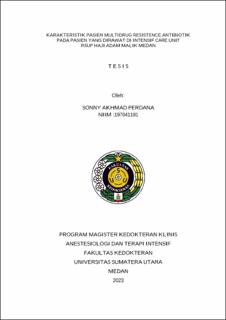| dc.description.abstract | Background Nosocomial infections are a serious problem for patients treated in the Intensive Care Unit (ICU), this is associated with significant treatment costs, long hospital stays, and increased morbidity and mortality rates. Patients admitted to the ICU have twice the risk of dying from infection than patients not admitted to the ICU. Patients with multidrug resistant (MDR) pathogens have a higher risk of death in the ICU than patients with non-MDR pathogens. Rapid and accurate identification of patients at high risk for colonization with MDR microorganisms is essential for the timely and targeted implementation of screening protocols and other preventive measures, as well as the provision of appropriate treatment (e.g., avoiding misuse of antibiotics).
Objective To determine the causes of multidrug resistance of antibiotics in patients treated in the ICU of General Hospital Haji Adam Malik Medan.
Method This research was conducted with a cross sectional design with a retrospective research method with secondary data sources obtained from the ICU medical records of General Hospital Haji Adam Malik Medan for the period September 2022- September 2023. The samples collected were 100 samples.
Results As many as 69% of the samples were men, the average age was 52.8 52,8
± 15,2 years, the average length of stay was 14.6 days, 57 samples had severe conditions, chronic kidney failure was the most ballast disease with 24 samples, and the most resistant antibiotic was cefazolin with 89%. and the most resistant antibiotic was cefazolin with 89%. The most culture results in MDR patients were Acinetobacter baumanni as many as 39 samples.
Conclusion Patients with multidrug resistance antibiotics are dominated by men, aged 52,8 ± 15,2 years, with the highest culture results for Acinetobacter baumannii. The most antibiotics given when the patient was initially admitted to the hospital was ceftriaxone, the highest culture results were resistant to the antibiotic cefazolin. | en_US |




